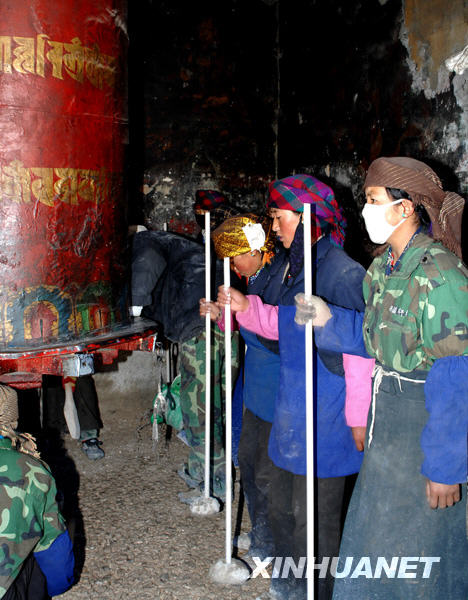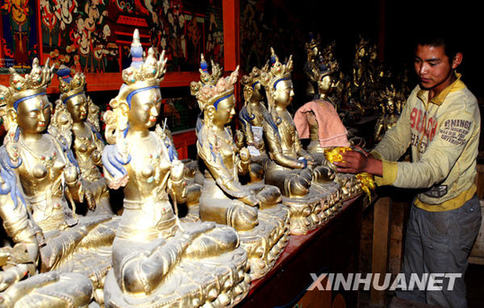
Maintenance of Changzhub Monastery in Lhoka Prefecture of Tibet estimated at 28.58 million yuan, started on October 15, 2008, photo from Xinhua.

A staff of the Changzhub Monastery is maintaining the cultural heritages, October 23, 2008, photo from Xinhua.
Five projects out of 22 totalling of the 11th-Five-Year Plan for repairing temples or monasteries in Tibet Autonomous Region, southwestern China, have already put in practice, according to the region's work conference of cultural heritages held on Tuesday.
Following the three key cultural heritages renovation project including the Potala Palace, Norbu Lingka and Sagya Monastery, valued at 330 million yuan, China again invested 570 million yuan to renovate more Tibetan architectures in large scale.
The State Development and Reform Committee allocated 280 million yuan while the rest was invested by the Ministry of Finance.
"Renovation projects on Tashilhunpo, Sangkagudu, Changzhub, Xalhu and Kegya monasteries have already put in practice after the 11th-Five-Year Plan officially started last year," said Nyima Tsering, head of the local bureau of culture.
A total of 22 cultural units are to be repaired in next few years.
Tibet holds abundant cultural resources with around 2,300 found by far. Since the peaceful liberation of Tibet, especially after China introduced the reform and opening-up policy, China has invested a total of more than 700 million yuan to reopen around 1,400 temples, cultural units and religionary scenes in Tibet.
"This is the largest in scale and most in investment of one lump sum renovation that China has ever practiced in Tibet," said Yu Dawa, head of Tibet Bureau of Cultural Heritages.
The renovation contains 22 cultural units including the Tashilhunpo Monastery, Xalhu Monastery, Jokhang Temple, Ramoche Monastery, Gyangze Anti-British Battle... and other 7 cultural items.
Renovation of the Tashilunpo Monastery, the permanent residence to Panchan Lamas as well as the biggest monastery of the Yellow Sect in Tibet, with 120 million yuan, is the most costly one among all.
